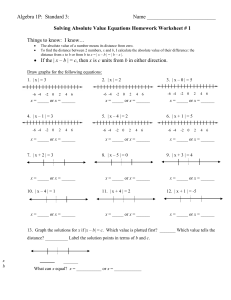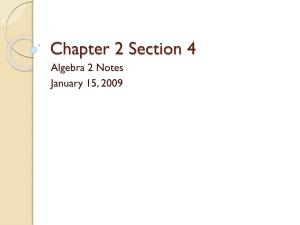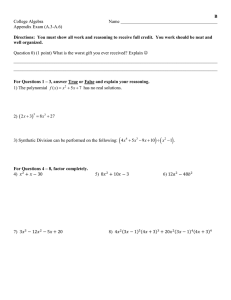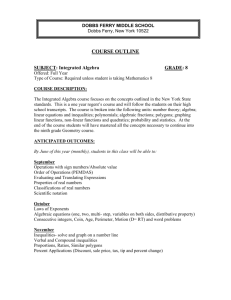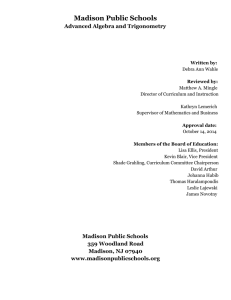Document 11465875
advertisement
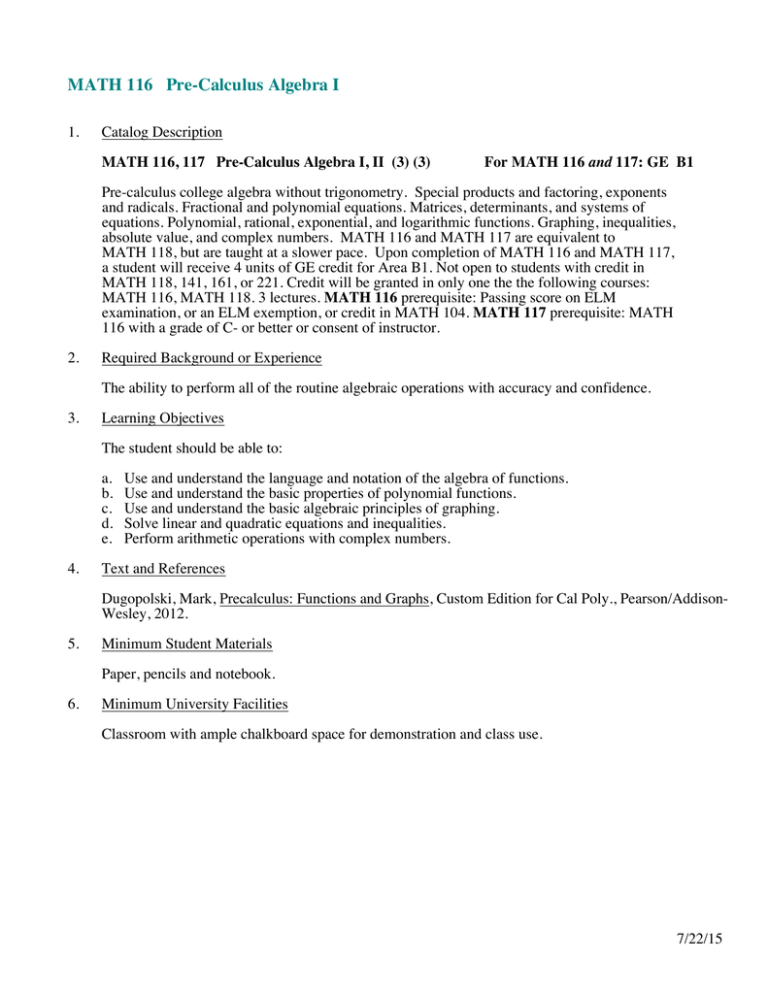
MATH 116 Pre-Calculus Algebra I 1. Catalog Description MATH 116, 117 Pre-Calculus Algebra I, II (3) (3) For MATH 116 and 117: GE B1 Pre-calculus college algebra without trigonometry. Special products and factoring, exponents and radicals. Fractional and polynomial equations. Matrices, determinants, and systems of equations. Polynomial, rational, exponential, and logarithmic functions. Graphing, inequalities, absolute value, and complex numbers. MATH 116 and MATH 117 are equivalent to MATH 118, but are taught at a slower pace. Upon completion of MATH 116 and MATH 117, a student will receive 4 units of GE credit for Area B1. Not open to students with credit in MATH 118, 141, 161, or 221. Credit will be granted in only one the the following courses: MATH 116, MATH 118. 3 lectures. MATH 116 prerequisite: Passing score on ELM examination, or an ELM exemption, or credit in MATH 104. MATH 117 prerequisite: MATH 116 with a grade of C- or better or consent of instructor. 2. Required Background or Experience The ability to perform all of the routine algebraic operations with accuracy and confidence. 3. Learning Objectives The student should be able to: a. b. c. d. e. 4. Use and understand the language and notation of the algebra of functions. Use and understand the basic properties of polynomial functions. Use and understand the basic algebraic principles of graphing. Solve linear and quadratic equations and inequalities. Perform arithmetic operations with complex numbers. Text and References Dugopolski, Mark, Precalculus: Functions and Graphs, Custom Edition for Cal Poly., Pearson/AddisonWesley, 2012. 5. Minimum Student Materials Paper, pencils and notebook. 6. Minimum University Facilities Classroom with ample chalkboard space for demonstration and class use. 7/22/15 Math 116, Page 2. 7. Content and Method Topic Lectures Chapter 1: 1.1 1.2 1.3 1.4 1.6 1.7 1.8 Equations, Inequalities, and Modeling Equations in One Variable Constructing Models to Solve Problems Equations and Graphs in Two Variables Linear Equations in Two Variables Complex Numbers Quadratic Equations Linear and Absolute Value Inequalities 10 Chapter : 3.1 3.2 3.3 3.4 3.5 3.6 Functions and Graphs Functions Graphs of Relations and Functions Families of Functions, Transformations, and Symmetry Operations with Functions Inverse Functions Constructing Functions with Variation 8 Chapter 5: 5.1 5.2 5.3 Polynomial and Rational Functions Quadratic Functions and Inequalities Zeros of Polynomial Functions The Theory of Equations 6 Total 8. ____ 24 Methods of Assessment The primary methods of assessment are, in decreasing order of importance: essay examinations, quizzes and homework. Typically, there will be two or three hour-long examinations during the quarter, and a comprehensive final examination. Students are required to show their work, and are graded not only on the correctness of their answers, but also on their understanding of the concepts and techniques. Quizzes are usually given once or twice a week to provide a spot check of student learning. Homework is required daily. Since this class satisfies a General Education requirement, at least 10% of the grade must be based on writing using correct mathematical notation. 9. Additional Comments a. The text has many interesting applications. Also note the review sections at the end of each chapter. b. The text is readable; students should be advised to read each section before coming to class. c. The text is bundled with several supplements: The Student’s Solutions Manual, Math XL®, and the Digital Video Tutor. See the preface of the text for additional information. d. Additional instructor supplements (test banks, etc.) are available from the course supervisor. 7/22/15


